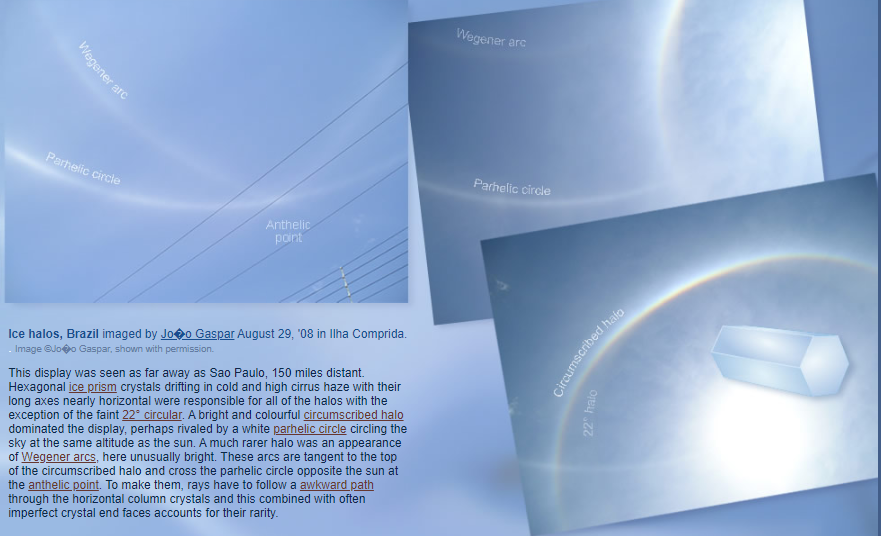Brazil Halos
Brazil Halos: A Spectacular Atmospheric Optics Phenomenon
The enchanting phenomenon of ice halos in Brazil is a captivating display that never fails to mesmerize onlookers. One such occurrence was observed by João Gaspar on August 29, '08, in Ilha Comprida, which was visible as far as Sao Paulo, approximately 150 miles away. This remarkable event showcased hexagonal ice prism crystals suspended in the cold and high cirrus haze, with their long axes almost parallel to the horizon. These unique ice crystals were the key players responsible for the formation of various halos, with the exception of the faint 22° circular halo.
Among the array of halos witnessed during this event, one particularly stood out with its vibrant and colorful presence. Known as the circumscribed halo, it dominated the spectacle and captivated observers with its brilliance. Alongside this magnificent display, another halo known as the white parhelic circle adorned the sky at the same altitude as the sun, adding an extra touch of wonder to the scene.
However, it was the appearance of Wegener arcs that truly made this event exceptional. Unusually bright in this instance, these arcs were tangent to the top of the circumscribed halo and intersected the parhelic circle opposite the sun at a point known as the anthelic point. The formation of Wegener arcs requires rays of light to follow an intricate path through the horizontal column crystals. The combination of this complex trajectory and the occasional imperfections in crystal end faces contribute to their rarity.
The occurrence of such a captivating atmospheric optics phenomenon raises several questions and sparks curiosity about the underlying science. Let's delve deeper into the fascinating world of Brazil halos and explore some intriguing aspects surrounding this remarkable spectacle:
-
Hexagonal Ice Prism Crystals: The formation of ice halos relies on the presence of hexagonal ice prism crystals suspended in the atmosphere. These crystals, with their unique shape and orientation, play a crucial role in bending and refracting sunlight to create the mesmerizing halo displays.
-
Cirrus Haze: The cold and high cirrus haze acts as the canvas upon which the ice halos manifest their ethereal beauty. The presence of this haze provides the necessary conditions for the hexagonal ice prism crystals to suspend and align themselves, setting the stage for the breathtaking spectacle.
-
Circumscribed Halo: The circumscribed halo is a prominent feature of the Brazil halo display. It encompasses a wide range of colors and encircles the sun, creating a halo effect that captivates observers. The exact mechanism behind the formation of this halo involves intricate interactions between light and ice crystals.
-
Parhelic Circle: The white parhelic circle adds an extra layer of enchantment to the Brazil halo display. It appears at the same altitude as the sun, encircling the sky and complementing the other halos. Understanding the formation of this circle sheds light on the complex dynamics of light refraction and reflection within the ice crystals.
-
Wegener Arcs: Wegener arcs, known for their rarity, add a touch of magic to the Brazil halo event. These arcs intersect both the circumscribed halo and the parhelic circle, creating a visually striking phenomenon. Exploring the unique conditions required for the formation of Wegener arcs deepens our understanding of the intricate processes involved in ice halo formation.
-
Crystal Structure and Imperfections: The crystal structure of ice prism crystals and their occasional imperfections contribute to the rarity and uniqueness of certain halo formations. Investigating the relationship between crystal characteristics and halo appearance provides valuable insights into the underlying mechanisms at play.
The Brazil halo event observed by João Gaspar offers a glimpse into the captivating world of atmospheric optics. From the mesmerizing circumscribed halo to the rare appearance of Wegener arcs, this phenomenon showcases the intricate interplay between light and ice crystals suspended in the atmosphere. By delving into the scientific intricacies of Brazil halos, we can gain a deeper appreciation for the wonders that unfold above us in the sky.

Ice halos, Brazil imaged by Jo�o Gaspar August 29, '08 in Ilha Comprida. . Image ©Jo�o Gaspar, shown with permission.
This display was seen as far away as Sao Paulo, 150 miles distant. Hexagonal ice prism crystals drifting in cold and high cirrus haze with their long axes nearly horizontal were responsible for all of the halos with the exception of the faint 22° circular. A bright and colourful circumscribed halo dominated the display, perhaps rivaled by a white parhelic circle circling the sky at the same altitude as the sun. A much rarer halo was an appearance of Wegener arcs, here unusually bright. These arcs are tangent to the top of the circumscribed halo and cross the parhelic circle opposite the sun at the anthelic point. To make them, rays have to follow a awkward path through the horizontal column crystals and this combined with often imperfect crystal end faces accounts for their rarity.
Note: this article has been automatically converted from the old site and may not appear as intended. You can find the original article here.
Reference Atmospheric Optics
If you use any of the definitions, information, or data presented on Atmospheric Optics, please copy the link or reference below to properly credit us as the reference source. Thank you!
-
<a href="https://atoptics.co.uk/blog/brazil-halos/">Brazil Halos</a>
-
"Brazil Halos". Atmospheric Optics. Accessed on July 27, 2024. https://atoptics.co.uk/blog/brazil-halos/.
-
"Brazil Halos". Atmospheric Optics, https://atoptics.co.uk/blog/brazil-halos/. Accessed 27 July, 2024
-
Brazil Halos. Atmospheric Optics. Retrieved from https://atoptics.co.uk/blog/brazil-halos/.